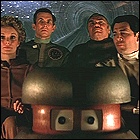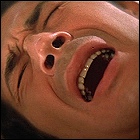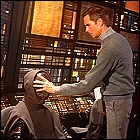 In the 22nd century, the crew of the small deep space probe Palomino find themselves dangerously close to an enormous black hole. VINCENT, the ship’s all-purpose robot, spots the silhouette of another space vessel against the enormity of the black hole, identifying it as the U.S.S. Cygnus, the largest American manned deep space mission ever launched, which stopped reporting back home twenty years before. More intriguing than the discovery of the Cygnus is the fact that the enormous ship is holding its own against the black hole’s gravity. Trying to investigate the Cygnus, the Palomino is caught in the gravity field of the black hole and sustains major damage. Forced to seek refuge near the Cygnus, the crew discovers a field of zero gravity around the large ghost ship. An even bigger surprise awaits when the Cygnus lights up without warning, after failing to respond to numerous attempts at communication from the Palomino. Palomino Captain Holland, along with scientists Kate McCrae and Alex Durant and blustery reporter Harry Booth, explore the ship with VINCENT, but it soon becomes apparent that someone – or something – is leading them carefully to the bridge of the ship and keeping them from other parts of the ship. The bridge is populated by robed robots, much to the disappointment of Kate, whose father was part of the original Cygnus crew. An enormous red robot appears and threatens the crew, and VINCENT puts himself between his crewmates and the menacing machine. A voice from the dimly-lit captain’s chair calls the robot off, and welcomes Holland and his crew aboard. It is Dr. Hans Reinhardt, the Cygnus’ legendary eccentric commander. Reinhardt tells the story of the Cygnus encountering a disaster which forced the crew to abandon ship, and caused the death of McCrae’s father. Reinhardt also reveals that he has developed the anti-gravity field that allows the Cygnus to maintain its position to study the black hole, but in the course of further conversation it also becomes apparent that Reinhardt may be mentally unstable. And despite Reinhardt’s order to help the Palomino crew find parts to repair their ship, his robot Maximillian makes no secret of the fact that it would like nothing more than to turn VINCENT into scrap metal.
In the 22nd century, the crew of the small deep space probe Palomino find themselves dangerously close to an enormous black hole. VINCENT, the ship’s all-purpose robot, spots the silhouette of another space vessel against the enormity of the black hole, identifying it as the U.S.S. Cygnus, the largest American manned deep space mission ever launched, which stopped reporting back home twenty years before. More intriguing than the discovery of the Cygnus is the fact that the enormous ship is holding its own against the black hole’s gravity. Trying to investigate the Cygnus, the Palomino is caught in the gravity field of the black hole and sustains major damage. Forced to seek refuge near the Cygnus, the crew discovers a field of zero gravity around the large ghost ship. An even bigger surprise awaits when the Cygnus lights up without warning, after failing to respond to numerous attempts at communication from the Palomino. Palomino Captain Holland, along with scientists Kate McCrae and Alex Durant and blustery reporter Harry Booth, explore the ship with VINCENT, but it soon becomes apparent that someone – or something – is leading them carefully to the bridge of the ship and keeping them from other parts of the ship. The bridge is populated by robed robots, much to the disappointment of Kate, whose father was part of the original Cygnus crew. An enormous red robot appears and threatens the crew, and VINCENT puts himself between his crewmates and the menacing machine. A voice from the dimly-lit captain’s chair calls the robot off, and welcomes Holland and his crew aboard. It is Dr. Hans Reinhardt, the Cygnus’ legendary eccentric commander. Reinhardt tells the story of the Cygnus encountering a disaster which forced the crew to abandon ship, and caused the death of McCrae’s father. Reinhardt also reveals that he has developed the anti-gravity field that allows the Cygnus to maintain its position to study the black hole, but in the course of further conversation it also becomes apparent that Reinhardt may be mentally unstable. And despite Reinhardt’s order to help the Palomino crew find parts to repair their ship, his robot Maximillian makes no secret of the fact that it would like nothing more than to turn VINCENT into scrap metal.
VINCENT finds an old robot called BOB, a much earlier version of his own design, in charge of the ship’s equipment stores. BOB has been obviously been terrorized and brutalized by Maximillian in the past, but finally reveals some vital information to VINCENT: Reinhardt’s crew mutinied against him when the scientist took it upon himself to rewrite the mission of the Cygnus, and Kate’s father was murdered in retaliation. The rest of the crew is still aboard – their minds wiped and reprogrammed by Reinhardt, they are, in fact, the legions of shrouded “robots” who solemnly attend the ship’s stations. Alex becomes intoxicated by Reinhardt’s misguided genius, and Harry sees nothing less than the story of the century (with his byline, of course). VINCENT warns Holland, Pizer and Kate of the deadly secrets of the Cygnus, and when Kate tells Alex, Maximillian kills him. Reinhardt’s new mission is to defy the laws of nature, drive the Cygnus through the black hole, and find out what – if anything – is on the other side. And he wants his visitors to help him…or die.
screenplay by Jeb Rosebrook and Gerry Day
story by Jeb Rosebrook and Bob Barbash & Richard Landau
directed by Gary Nelson
music by John BarryCast: Maximilian Schell (Dr. Hans Reinhardt), Anthony Perkins (Dr. Alex Durant), Robert Forster (Captain Dan Holland), Joseph Bottoms (Lt. Charles Pizer), Yvette Mimieux (Dr. Kate McCrae), Ernest Borgnine (Harry Booth), Roddy McDowall (voice of VINCENT), Slim Pickens (voice of BOB), Tommy McLoughlin (STAR)
Notes: Early in the movie, when VINCENT has to fire a tether out of his back to secure himself to the hull of the Palomino, the sound heard is quite familiar – it’s the sound of the Enterprise’s turbolift doors opening from the original Star Trek.
LogBook entry and review by Earl Green
Review: You’re probably saying to yourself, “Go ahead, admit this movie is one of your guilty pleasures from childhood.” I adamantly refuse to say any such thing. This movie is still one of my favorites even today. The long distance shots of the black hole are truly cool – later in the movie, when the spaceships move closer and eventually plunge into what is obviously a red-tinted whirlpool of water, the black  hole is much less menacing – and the Cygnus in particular has an interestingly grandiose design somewhere between a cathedral and a greenhouse. But my favorite thing about this movie? The robots! What cool robots! We’re not talking about the walking tin men which are so obviously costumed actors. I like the little round guys, VINCENT and BOB. Admittedly, BOB’s old-timey Western voice treatment is silly – did he always sound like that, or did he download a new voice patch after he’d been beaten up a bit? – but VINCENT is one of the all-time coolest robots ever to grace the big screen. Cool voice, cool anti-gravity schtick, and a great blend of anthropomorphic features, robot-ish-ness, and cuteness. Who cares if he spent the entire movie hanging from piano wire? I don’t. I loved VINCENT. Maximillian, on the other hand – the big red robot who carves up Anthony Perkins like so much Thanksgiving turkey – scared the piss out of me for years after I first saw the movie.
hole is much less menacing – and the Cygnus in particular has an interestingly grandiose design somewhere between a cathedral and a greenhouse. But my favorite thing about this movie? The robots! What cool robots! We’re not talking about the walking tin men which are so obviously costumed actors. I like the little round guys, VINCENT and BOB. Admittedly, BOB’s old-timey Western voice treatment is silly – did he always sound like that, or did he download a new voice patch after he’d been beaten up a bit? – but VINCENT is one of the all-time coolest robots ever to grace the big screen. Cool voice, cool anti-gravity schtick, and a great blend of anthropomorphic features, robot-ish-ness, and cuteness. Who cares if he spent the entire movie hanging from piano wire? I don’t. I loved VINCENT. Maximillian, on the other hand – the big red robot who carves up Anthony Perkins like so much Thanksgiving turkey – scared the piss out of me for years after I first saw the movie.
It’s a common criticism that the whole thing is a sci-fi retelling of 20,000 Leagues Under The Sea, though it didn’t start out that way; Disney originally developed the movie as a “family disaster movie” – a sort of sci-fi version of The Poseidon Adventure with a nuclear family as the protagonists. (If VINCENT seems a bit cutesy in the context of the finished film, bear in mind that the robot was probably originally designed to play off of a cast that was slated to include children.) Languishing in development hell since the early ’70s, that original concept – under the working title of Space Probe One (which survives into the filming script as the boilerplate designation for the U.S.S. Cygnus) – was dusted off post-Star Wars and rushed into production.
The star-studded cast does an admirable job; only Joseph Bottoms and the venerable Ernest Borgnine ever really seem to overdo it. As the young hotshot pilot of the crew, Bottoms plays well off of Robert Forster’s cool-headed astronaut straight from the Right Stuff mold. Borgnine winds up playing… well… the same character Borgnine always seems to play. Anthony Perkins provides the real “edge” of the cast, as Dr. Durant vascillates between being in awe of Reinhardt and being in terror of him, and his actions lead not only to his own death, but the endangerment of his fellow crewmates. Maximilian Schell is probably more actor than The Black Hole needs or deserves, but he nicely anchors the opposite end of the ends-justifies-the-means tug-of-war at the heart of the story.
The end sequence, starting roughly where the surviving crew members realize they’re on a direct course for the black hole, is an astonishingly bizarre montage of surreal sounds and images which, while they seem a to be suggesting several more specific concepts than 2001‘s wild end sequence, are still a kind of celluloid Rorschach test for the viewer. Now, some of the scenes are pretty broadly  obvious – if you somehow miss the suggestion of a journey through Hell with a capital H right out of the Old Testament, you may need some new contact lenses. And it helps that this entire montage is liberally drenched with some of the best music John Barry ever created. Okay, maybe the 2001 comparison is indeed far-fetched. But one has to admire the mythical-impressionistic-hallucinogenic atmosphere of this part of the movie, which refuses to nail down if this is something the crew is actually experiencing or, more likely, an impressionistic view of their experience filtered through their beliefs. Rather like everything about this movie, it was well outside of the usual bounds of Disney fare of the time (remember, this movie came out long before Touchstone Pictures ever existed). One trick I can’t figure out is how the camera kept spinning around and even under the crew’s seats while simultaneously doing a constant 360-degree yaw tumble. Years before the remake of Cape Fear, this must have been one hell of a camera rig.
obvious – if you somehow miss the suggestion of a journey through Hell with a capital H right out of the Old Testament, you may need some new contact lenses. And it helps that this entire montage is liberally drenched with some of the best music John Barry ever created. Okay, maybe the 2001 comparison is indeed far-fetched. But one has to admire the mythical-impressionistic-hallucinogenic atmosphere of this part of the movie, which refuses to nail down if this is something the crew is actually experiencing or, more likely, an impressionistic view of their experience filtered through their beliefs. Rather like everything about this movie, it was well outside of the usual bounds of Disney fare of the time (remember, this movie came out long before Touchstone Pictures ever existed). One trick I can’t figure out is how the camera kept spinning around and even under the crew’s seats while simultaneously doing a constant 360-degree yaw tumble. Years before the remake of Cape Fear, this must have been one hell of a camera rig.
The Black Hole has spent over 30 years being crapped on by critics, but in retrospect it deserves a bit more respect. Released in a year that also saw the debut of Star Trek: The Motion Picture, The Black Hole shares with that movie an attempt to do serious science  fiction in the same vein as 2001 (inasmuch as there are major scenes or plot elements that the audience is left to interpret without the movie trying to explain everything). Unlike Star Trek, which had perhaps gained a reputation for being a more serious saga than it had been on TV, The Black Hole was hampered somewhat by the demands and built-in restrictions of the studio releasing it, which is probably why you’re raising your eyebrows at me for even daring to mention The Black Hole and 2001 in the same paragraph. Though not the first PG-rated Disney film produced, it was the first PG-rated Disney film released, and this caused a huge uproar at the time, leading directly to the formation of such Disney-owned entities as Touchstone Pictures, which were free to develop more adult fare. If nothing else, it was a brave attempt.
fiction in the same vein as 2001 (inasmuch as there are major scenes or plot elements that the audience is left to interpret without the movie trying to explain everything). Unlike Star Trek, which had perhaps gained a reputation for being a more serious saga than it had been on TV, The Black Hole was hampered somewhat by the demands and built-in restrictions of the studio releasing it, which is probably why you’re raising your eyebrows at me for even daring to mention The Black Hole and 2001 in the same paragraph. Though not the first PG-rated Disney film produced, it was the first PG-rated Disney film released, and this caused a huge uproar at the time, leading directly to the formation of such Disney-owned entities as Touchstone Pictures, which were free to develop more adult fare. If nothing else, it was a brave attempt.
One wonders what the in-development remake – currently being cooked up by the writers behind Tron Legacy – might be able to do better. I doubt that it’ll be able to find the same unique look and feel of the original, though.

